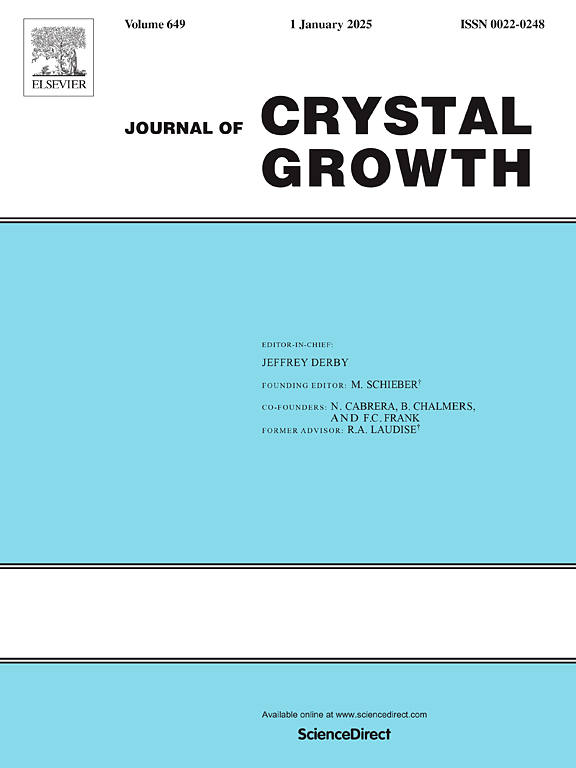Characterization of phosphorus deactivation in epitaxial Si:P and surpassing 1021 cm−3 carrier concentration
IF 1.7
4区 材料科学
Q3 CRYSTALLOGRAPHY
引用次数: 0
Abstract
Deactivation behavior of epitaxial phosphorus-doped silicon, Si:P, was analyzed using a combination of Hall effect measurement and high-resolution X-ray diffraction. Processing at two different temperatures provided the ability to determine when the deactivation mechanism transitions from thermally-driven to primarily dopant-density driven. For < 500 °C growth temperature, a minimum resistivity of 0.258 ± 0.003 mΩ-cm was observed at (2.88 ± 0.02)% total P with active carrier concentration, n, of (7.18 ± 0.09) × 1020 cm−3 equating to (50.1 ± 1.9)% active dopant. In contrast, maximum n = (7.76 ± 0.09) × 1020 cm−3 was seen at (4.32 ± 0.02)% P. For < 400 °C growth temperature, a minimum resistivity of 0.214 ± 0.002 mΩ-cm was measured at (2.97 ± 0.02)% P with n = (1.01 ± 0.01) × 1021 cm−3 which is (67.9 ± 1.7)% active dopant. Maximum n = (1.09 ± 0.02) × 1021 cm−3 was at (4.11 ± 0.02)% P, again different than resistivity minimum. Lower temperature processing pushed the active dopant amount for maximum n from (35.7 ± 1.6)% to (53.0 ± 1.9)%, at nearly identical %P, meaning deactivation is indeed inhibited. This benefit appears to dissipate at ∼ 5.5 % P, based on converging resistivity and active dopant dependences, indicating the onset of dopant-density driven deactivation. Growth at < 400 °C also provided near-unity (96.0 ± 2.2)% active dopant [where n = (7.51 ± 0.07) × 1020 cm−3] at (1.57 ± 0.02)% P giving 0.247 ± 0.003 mΩ-cm resistivity. Both ionized and non-ionized (inactive) dopants were shown to influence mobility, with the latter coming on at ∼ 50 % inactive dopant and causing a maximum decrease of ∼ 7 cm2/V-s with the %P range considered here. Threshold and maximum were both independent of growth temperature. These results have implications on Si:P optimization for contact versus for bulk resistivity as well as lowering both resistivities overall.
外延Si:P中磷失活特性及超过1021 cm−3载流子浓度
采用霍尔效应测量和高分辨率x射线衍射相结合的方法分析了外延掺磷硅Si:P的失活行为。在两种不同的温度下处理提供了确定失活机制何时从热驱动转变为主要由掺杂剂密度驱动的能力。& lt;在500℃的生长温度下,在(2.88±0.02)%的总磷下,活性载流子浓度n为(7.18±0.09)× 1020 cm−3,相当于(50.1±1.9)%的活性掺杂剂,电阻率最小值为0.258±0.003 mΩ-cm。相比之下,最大n =(7.76±0.09)× 1020 cm−3为(4.32±0.02)% p。在(2.97±0.02)% P下,n =(1.01±0.01)× 1021 cm−3(67.9±1.7)%活性掺杂,测得最小电阻率为0.214±0.002 mΩ-cm。最大n =(1.09±0.02)× 1021 cm−3在(4.11±0.02)% P处,也与电阻率最小值不同。低温处理将最大n的活性掺杂量从(35.7±1.6)%提高到(53.0±1.9)%,在几乎相同的%P下,这意味着失活确实被抑制了。根据收敛电阻率和活性掺杂剂依赖性,这种益处在~ 5.5% P时消散,表明掺杂剂密度驱动的失活开始。增长<;在(1.57±0.02)% P下,400°C也提供了接近统一的(96.0±2.2)%活性掺杂剂[其中n =(7.51±0.07)× 1020 cm−3],电阻率为0.247±0.003 mΩ-cm。研究表明,电离和非电离(非活性)掺杂剂都会影响迁移率,后者在掺杂剂的非活性达到~ 50%时发生,并导致最大降低~ 7 cm2/V-s,此处考虑的是%P范围。阈值和最大值均与生长温度无关。这些结果对Si:P接触电阻率与体电阻率的优化以及总体上降低两者的电阻率具有重要意义。
本文章由计算机程序翻译,如有差异,请以英文原文为准。
求助全文
约1分钟内获得全文
求助全文
来源期刊

Journal of Crystal Growth
化学-晶体学
CiteScore
3.60
自引率
11.10%
发文量
373
审稿时长
65 days
期刊介绍:
The journal offers a common reference and publication source for workers engaged in research on the experimental and theoretical aspects of crystal growth and its applications, e.g. in devices. Experimental and theoretical contributions are published in the following fields: theory of nucleation and growth, molecular kinetics and transport phenomena, crystallization in viscous media such as polymers and glasses; crystal growth of metals, minerals, semiconductors, superconductors, magnetics, inorganic, organic and biological substances in bulk or as thin films; molecular beam epitaxy, chemical vapor deposition, growth of III-V and II-VI and other semiconductors; characterization of single crystals by physical and chemical methods; apparatus, instrumentation and techniques for crystal growth, and purification methods; multilayer heterostructures and their characterisation with an emphasis on crystal growth and epitaxial aspects of electronic materials. A special feature of the journal is the periodic inclusion of proceedings of symposia and conferences on relevant aspects of crystal growth.
 求助内容:
求助内容: 应助结果提醒方式:
应助结果提醒方式:


